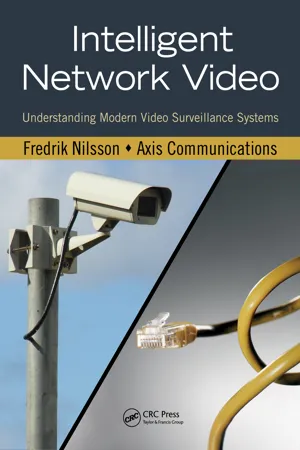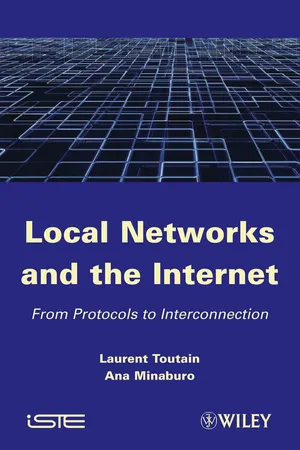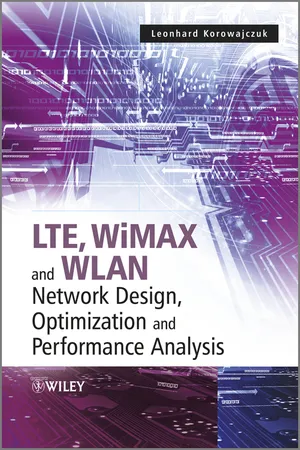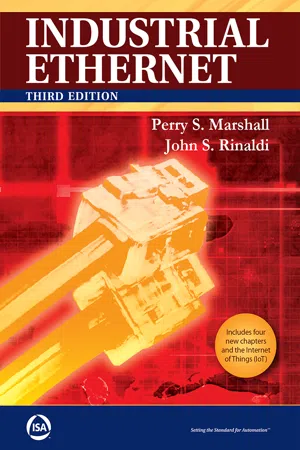Network Protocols
Network protocols are a set of rules and conventions that govern communication between devices on a network. They define how data is formatted, transmitted, received, and acknowledged. Examples of network protocols include TCP/IP, HTTP, and FTP, each serving specific purposes such as data transfer, web browsing, and email communication.
7 Key excerpts on "Network Protocols"
- eBook - ePub
Wireless Sensors and Instruments
Networks, Design, and Applications
- Halit Eren(Author)
- 2018(Publication Date)
- CRC Press(Publisher)
...An intranet is established using the same architecture and standards (e.g., TCP/IP) as the Internet. Most intranets are connected to the Internet to provide authorized users with access to a wider range of resources. The connection of two or more intranets forms an extranet. 3.4 Protocols As networks become more complex and wide reaching, the requirements for linking devices to networks and the interlinking networks themselves continue to grow. Thus the need for rules, regulations, and standards for successful connections increases proportionately. This leads to rules and standards that are accepted and practiced at national and international levels. A protocol is a set of rules that are agreed to by relevant authorities to enable successful communication between devices. In the simplest case of two devices communicating with each other, they must share a common set of rules and procedures about how to communicate and exchange information. At this minimum level, such rules may include how to interpret signals, how to identify oneself and others on the network, how to initiate and end communication, how to manage the exchange of information across the network medium, and so on. Protocols must be comprehensive enough to regulate all essential requirements of a communication system...
- Viktor Boed(Author)
- 1999(Publication Date)
- CRC Press(Publisher)
...4 Network Protocols Viktor Boed CONTENTS Introduction OSI Lower Layer Protocols Ethernet (IEEE 802.3) Interconnecting LAN Ethernet Repeaters Bridges Routers Gateways ARCNET Transmission Control Protocol/Internet Protocol (TCP/IP) Internet Protocol Transmission Control Protocol Appendix: Data Communications Standards Introduction The most common classification of networks for data, voice, and graphic communications are local area networks (LAN), wide area networks (WAN), and metropolitan area networks (MAN). Due to the size of most facilities (campus, research, production, etc.), LANs seem to prevail in facilities automation applications. LANs became very popular for two main reasons: Data sharing Resource sharing From their PC workstations connected to the LAN, users can access other computers connected to the network, files allocated on network computers, or dedicated file servers and drives. LANs (also referred to as “information highways”) can be shared by various systems utilized by facilities, such as: Office systems (E-mail, word processing, accounting) Engineering systems (computerized design and drafting, project management) O&M systems (work scheduling, inventory control) Real-time systems (building automation, power plant, metering, security, CATV, and other systems) The condition for coexistence of computerized systems on the same network assumes they all have network-compatible communications protocols. Network Protocols — proprietary, open, and standard — are utilized for interfacing computerized systems connected to the network. Standard protocols are based on the OSI model. The majority of industry standard or proprietary protocols adhere to some degree to the structure of the OSI model...
- eBook - ePub
Intelligent Network Video
Understanding Modern Video Surveillance Systems, Second Edition
- Fredrik Nilsson, Communications Axis(Authors)
- 2016(Publication Date)
- CRC Press(Publisher)
...C HAPTER 11 Networking technologies DOI: 10.1201/9781315399904-11 Networking technology has experienced tremendous development over the past decades. Today, billions of people globally are using networking technology, tens of billions of devices are connected to networks and the internet, and the numbers are growing fast. The technology is quite complex, but most users are not exposed to this. When a user switches on their laptop, a series of networking technologies is automatically initiated to ensure that the laptop gets an Internet Protocol (IP) address and that the network communication is secure. The IP is the common denominator in network technology, and although it was originally designed for military communications, today it is also used in small home networks, enterprise local area networks (LANs), and the internet for applications such as email, web browsing, telephony, and network video. Many different protocols come into play when data are transferred securely from one networked device to another. The best way to understand how the different protocols interact is to examine the Open Systems Interconnection (OSI) communication model, as explained in the first section of this chapter. The IP is discussed extensively in the middle of the chapter, followed by a section on a topic that is becoming increasingly important as network use continues to grow, network security—sometimes referred to as cybersecurity. 11.1 OSI REFERENCE MODEL Data communication between open systems is described using the OSI Reference Model, which is composed of seven layers (Figure 11.1). Each layer provides specific services and makes the results available to the next layer. To provide a service, each layer utilizes the services of the layer immediately below it. Communication between layers occurs via specific interfaces. Each layer must follow certain rules, known as protocols, to perform its services...
- eBook - ePub
Cybercrime and Information Technology
Theory and Practice: The Computer Network Infostructure and Computer Security, Cybersecurity Laws, Internet of Things (IoT), and Mobile Devices
- Alex Alexandrou(Author)
- 2021(Publication Date)
- CRC Press(Publisher)
...doi: 10.1109/TCOM.1974.1092259. 12 Cerf, Vinton G., and Robert E. Icahn. “A protocol for packet network intercommunication.” ACM SIGCOMM Computer Communication Review 35, no. 2 (2005): 71–82. Later in the 1970s, the government decided to split TCP into two protocols. In 1981, UC Berkeley, working under a contract with DARPA, expanded TCP/IP to include error correction, segmentation, and reassembly. As a result, in 1981, the government eliminated the NCP and adopted TCP/IP as the official protocol for the ARPANET. 13 In 1983, the ARPANET replaced NCP with TCP/IP and allowed the ARPANET to split into MILNET for military and the ARPANET for research communications. 14 Figure 5.4 demonstrates key events in the development of the Internet. 13 Id. at 4. 14 Id. at 10. FIGURE 5.4 A timeline of key network and computer events. 5.1.2 The World Wide Web and the Internet The Internet and the World Wide Web (WWW) are not the same. The Internet is a global network of networks that are structured to connect each other, whereas the Web is a service that runs on top of this infrastructure. Imagine our lives today without it! In the past, the computer center was a room in the basement of a company from which all computer operations were run. With the introduction of networking and the ability to connect to resources and businesses around the world, the old room became outdated and was replaced by enterprise-wide data centers in various locations, with servers connected to the network. Now, these enterprise data centers have been overtaken by cloud computing, virtualization, mobile devices, and the Internet of Things (IoTs), all using edge computing paradigms and fog standards that bring their applications closer to the user. These are discussed more fully in Chapter 7. The connection into a network by any device occurs either wired or wirelessly. In a wired connection, we physically connect a computer into a router using Ethernet cables (Figure 5.5)...
- eBook - ePub
Local Networks and the Internet
From Protocols to Interconnection
- Laurent Toutain, Ana Minaburo(Authors)
- 2013(Publication Date)
- Wiley-ISTE(Publisher)
...Chapter 7 IP Protocols This chapter starts the section of the book dedicated to Internet Network Protocols. It covers the network organization and level 3 protocols (IP and associated protocols). This chapter also deals with the new version of the IP protocol, called IPv6. Chapter 8 will present level 4 protocols: UDP (User Datagram Protocol) and TCP (Transmission Control Protocol); and Chapter 9 the methods used to link the different protocol layers (ARP, RARP, DNS). 7.1. Implementation of the TCP/IP protocols The IP protocol transfers data in datagram mode, i.e. packets are processed independently. This allows us to have relatively simple and fast equipment within the network. The protocol was designed to ensure the routing and segmentation of data (adaptation of packet length to the size of data carried by level 2 frames). The goal of the IP protocol is to be able to build a worldwide network by adapting to every type of physical medium. RFCs defining the encapsulation rules of IP packets are: — Broadcast local network such as Ethernet (RFC 894, see Chapter 3, page 37). — Point-to-point links with PPP (see Chapter 16). — Traveling pigeons (RFC 1149 1); — X.25 (RFC 1356); — Frame relay (RFC 1490, see section 15.3); — ATM (RFC 1483, RFC 1577); — SDH (RFC 1619); — WiMAX (working group 16 ng); — DVB (working group ipdvb); — Sensor networks (working group 6 lowpan); — Etc. In a network, we can distinguish two types of equipment (see Figure 7.1). Equipment that is found at the end of the network (work stations, personal computers, printers, etc.) and that produce or consume data and routers located inside the network. Figure 7.1. Simplified architecture of the network 7.1.1. Terminal equipment Figure 7.2 represents the stack of protocols in a Unix system, but it also applies to the Windows system. These protocols are older than ISO’s normalization efforts. The seven-layer reference model is not, in principle, applicable...
- Leonhard Korowajczuk, Leonhard Korowajczuk(Authors)
- 2011(Publication Date)
- Wiley(Publisher)
...Chapter 2 Data Transmission Data transmission plays an important role in wireless broadband networks, and understanding this process is crucial to correctly dimension the network. The bulk of the data traffic handled by the networks will be the Internet, using TCP/IP protocol. Besides, all interconnections to the wireless system will come from wired networks, where the Ethernet prevails. 2.1 History of the Internet In the late 1960s, it became obvious that there was a need to interconnect computers. In 1970, the ISO (International Standards Organization) developed a reference model called OSI (Open System Interconnection), which defined a seven layers model. This model became the reference for comparing different protocols, but its full implementation was extensive and was not practical for the majority of the applications. This model was defined by a committee and lacked practical implementations. OSI-defined protocols were then developed by several entities such as the ITU-R (CCITT) X.25 for packet switching and EISA/TIA-232 and 422. Large computer manufacturers implemented proprietary OSI-based protocols such as SNA (System Network Architecture) from IBM or DSA (Distributed System Architecture) from Honeywell Bull and others. In the USA, the first attempts to interconnect different computer platforms at different locations were sponsored by DARPA (the Defense Advanced Research Projects Agency) through the implementation of the ARPANET (Advanced Research Projects Agency Network) in 1969. This network connected four universities, using Interface Message Processors (precursors of today's routers) at each location to store and forward packets of data. The hardware was implemented by BBN Technologies (Bolt, Beranek and Newman), a Massachusetts company. The design of the network was set so that it should only provide routing and transmission capabilities and that the remaining functionalities should stay on the periphery...
- eBook - ePub
- John Marshall(Author)
- 2017(Publication Date)
- International Society of Automation(Publisher)
...Each software program processes the data field remaining from being processed by the previous software layer. This is illustrated in Figure 4-3. Protocols in this suite work together by passing their messages up and down the protocol stack. For example, the TCP protocol (described later in this chapter) takes application data and embeds it in the data field of a TCP message. It then passes the TCP message to the IP protocol where the entire TCP message becomes the data packet of the IP message. At each layer of the TCP/IP protocol suite, the software layer is only concerned with its fields and not the contents provided by previous layers. The TCP/IP protocol suite is software and is usually a component of your computer’s operating system. In Microsoft Windows (R), Microsoft includes a TCP/IP protocol suite to process Ethernet messages. In industrial devices, the TCP/IP protocol suite may be included as part of an operating system or may be a separate software component. The number of programs included in the suite is dependent on the vendor but always includes both the Internet Protocol (IP) and Transmission Control Protocol (TCP). Figure 4-3. Data Flow Through the Hardware, IP Layer, and UDP/ TCP Layers to Applications 4.4 TCP/IP Protocol Suite – IP Protocol The IP part of the Internet Protocol Suite is the “Internet Protocol.” It is used for almost all Internet communication. When a host sends a packet, it figures out how to get the packet to its destination; when receiving packets, it figures out where they belong. Because it does not worry about whether packets get to where they are going, nor whether they arrive in the order sent, its job is greatly simplified. If a packet arrives with any problems (e.g., corruption), IP silently discards it. In addition to inter-network routing, IP provides error reporting and fragmentation and reassembly of packets for transmission over networks with different maximum data unit sizes...






